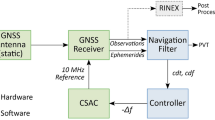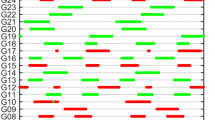Abstract
Inter-system bias (ISB) parameters are usually introduced in multi-GNSS processing. However, the differences in correlation processing within GNSS receivers can introduce signal distortion bias (SDB) into pseudorange observations. SDB differences of these satellites from the same constellation, similar to the GLONASS inter-frequency bias (IFB) related to individual frequencies, can cause intra-system biases. Based on multi-GNSS observations that consider intra-system bias, the relationship between intra-system and inter-system biases and their impacts on the multi-GNSS undifferenced (UD) model are analyzed in this article. Then, empirical calibration strategies are proposed. Ten receiver types from four manufacturers are selected to analyze the intra-system bias characteristics of code division multiple access (CDMA) and frequency division multiple access (FDMA), and the calibrations and improvements of the multi-GNSS solution are also analyzed. The results show that the intra-system biases of GPS and Galileo remain at the centimeter–decimeter level with 10-cm stability, while bias of BDS can reach several meters with worse stability. The intra-system biases of CDMA signals have stronger consistency among the same types of receivers than those of FDMA. One month of data verified the centimeter-level differences between ISB parameters that were independently estimated based on multi-GNSS precise products with unified datum and inter-constellation differences in intra-system biases. The pre-estimated intra-system bias can be used to calibrate pseudorange residuals and further promote the convergence speed of single or multi-GNSS precise point positioning (PPP), especially for BDS and GLONASS. Comparative experiments show that intra-system bias calibration can decrease the residual RMS of BDS by 22 cm on average and that of GLONASS by 41 cm, with 15% and 23% improvement rates, respectively. The convergence time of BDS PPP in the horizontal and vertical directions can be reduced by 10 min to half an hour with approximately 20–60% improvement rates. For GLONASS PPP, the convergence time can also be reduced by more than 40 min with a 50–90% improvement.














Similar content being viewed by others
Data availability
The test GNSS data can be accessed at ftp://cddis.gsfc.nasa.gov. The precise orbit and clock products can be obtained from ftp://ftp.gfz-potsdam.de/pub/pub/GNSS/products/mgex.
References
Bierman GJ (1977) Factorization methods for discrete sequential estimation. Academic Press Inc., New York
Chen L, Li M, Hu Z, Fang C, Geng C, Zhao Q, Shi C (2018) Method for real-time self-calibrating GLONASS code inter-frequency bias and improvements on single point positioning. GPS Solutions 22(4):111
Chen L, Li M, Zhao Y, Zheng F, Zhang X, Shi C (2021a) Clustering code biases between BDS-2 and BDS-3 satellites and effects on joint solution. Remote Sens 13(1):15
Chen L, Li M, Zhao Y, Hu Z, Zheng F, Shi C (2021b) Multi-GNSS real-time precise clock estimation considering correction of inter-satellite code bias. GPS Solut 25(2):32
Ge M, Gendt G, Rothacher M, Shi C, Liu J (2008) Resolution of GPS carrier-phase ambiguities in precise point positioning (PPP) with daily observations. J Geod 82(7):389–399
Ge M, Chen J, Douša J, Gendt G, Wickert J (2012) A computationally efficient approach for estimating high-rate satellite clock corrections in realtime. GPS Solutions 16(1):9–17
Gendt G, Dick G, Reigber CH, Tomassini M, Liu Y, Ramatschi M (2003) Demonstration of NRT GPS water vapor monitoring for numerical weather prediction in Germany. J Meteorol Soc Jpn 82(1B):360–370
Geng J, Chen X, Pan Y, Zhao Q (2019) A modified phase clock/bias model to improve PPP ambiguity resolution at Wuhan University. J Geodesy 93:2053–2067
Gong X, Gu S, Zheng F, Wu Q, Liu S, Lou Y (2021) Improving GPS and Galileo precise data processing based on calibration of signal distortion biases. Measurement 174(3):108981
Gong X, Zheng F, Gu S, Zhang Z, Lou Y (2022) The long-term characteristics of GNSS signal distortion biases and their empirical corrections. GPS Solut 26(2):52
Hahn JH, Powers ED (2005) Implementation of the GPS to Galileo time offset (GGTO),In: Proceedings of 2005 joint IEEE international frequency control symposium and precise time & time interval (PPTI) Systems & applications meeting, Vancouver, pp 33–37
Hauschild A, Steigenberger P, Montenbruck O (2019) Inter-receiver GNSS pseudorange biases and their effect on clock and DCB estimation. In: Proceedings ION GNSS+ 2019, Institute of Navigation, Miami, Florida, pp 3675–3685
Hauschild A, Montenbruck O (2016) A study on the dependency of GNSS pseudorange biases on correlator spacing. GPS Solut 20(2):159–171
Hegarty C, Powers E, Foville B (2004) Accounting for timing biases between GPS, modernized GPS, and Galileo signals. In: Proceedings of 36th annual precise time and time interval meeting, Washington DC, pp 307–317
Kouba J (2009) A guide to using international GNSS service (IGS) products. http://acc.igs.org/UsingIGSProductsVer21.pdf
Li M, Yuan Y (2021) Estimation and analysis of the observable-specific code biases estimated using multi-GNSS observations and global ionospheric maps. Remote Sens 13(16):3096
Li X, Zhang X, Ge M (2011) Regional reference network augmented precise point positioning for instantaneous ambiguity resolution. J Geod 85:151–158
Li X, Ge M, Dai X, Ren X, Fritsche M, Wickert J, Schuh H (2015) Accuracy and reliability of multi-GNSS real-time precise positioning: GPS, GLONASS, BeiDou, and Galileo. J Geod 89(6):607–635
Li R, Li Z, Wang N, Tang C, Ma H, Zhang Y, Wang Z, Wu J (2021) Considering inter-receiver pseudorange biases for BDS-2 precise orbit determination. Measurement 177:109251
Liu X, Jiang W, Chen H, Zhao W, Huo L, Huang L, Chen Q (2019) An analysis of inter-system biases in BDS/GPS precise point positioning. GPS Solut 23:116
Mi X, Zhang B, Odolinski R, Yuan Y (2020) On the temperature sensitivity of multi-GNSS intra- and inter-system biases and the impact on RTK positioning. GPS Solut 24(4):112. https://doi.org/10.1007/s10291-020-01027-5
Montenbruck O, Hauschild A, Hessels U (2011) Characterization of GPS/GIOVE sensor stations in the CONGO network. GPS Solut 15:193–205. https://doi.org/10.1007/s10291-010-0182-8
Montenbruck O, Hauschild A, Steigenberger P (2014) Differential code bias estimation using multi-GNSS observations and global ionosphere maps. Navigation 61(3):191–201
Montenbruck O, Steigenberger P, Prange L, Deng Z, Zhao Q, Perosanz F et al (2017) The multi-GNSS experiment (MGEX) of the international GNSS service (IGS)-achievements, prospects and challenges. Adv Space Res 59(7):1671–1697
Odijk D, Teunissen PJG (2013) Characterization of between-receiver GPS-Galileo inter-system biases and their effect on mixed ambiguity resolution. GPS Solut 17(4):521–533. https://doi.org/10.1007/s10291-012-0298-0
Odijk D, Zhang B, Khodabandeh A, Odolinski R, Teunissen PJG (2016) On the estimability of parameters in undifferenced, uncombined GNSS network and PPP-RTK user models by means of S-system theory. J Geodesy 90(1):15–44. https://doi.org/10.1007/s00190-015-0854-9
Odolinski R, Teunissen PJG, Odijk D (2015) Combined BDS, Galileo, QZSS and GPS single-frequency RTK. GPS Solut 19(1):151–163. https://doi.org/10.1007/s10291-014-0376-6
Paziewski J, Wielgosz P (2015) Accounting for Galileo-GPS inter-system biases in precise satellite positioning. J Geod 89:81–93. https://doi.org/10.1007/s00190-014-0763-3
Rebischung P, Schmid R (2016) IGS14/igs14.atx: a new framework for the IGS products. In: American geophysical union fall meeting 2016, San Francisco
Schaer S, Gurtner W, Feltens J (1998) IONEX: the ionosphere map exchange format version 1. In Proceedings of the IGS AC Workshop, Darmstadt, 9–11 Feb 1998
Shi C, Yi W, Song W, Lou Y, Yao Y, Zhang R (2013) GLONASS pseudorange inter-channel biases and their effects on combined GPS/GLONASS precise point positioning. GPS Solut 17(4):439–451
Steigenberger P, Fritsche M, Dach R, Schmid R, Montenbruck O, Uhlemann M, Prange L (2016) Estimation of satellite antenna phase center offsets for Galileo. J Geod 90(8):773–785
Wang N, Yuan Y, Li Z, Montenbruck O, Tan B (2016) Determination of differential code biases with multi-GNSS observations. J Geod 90(2):209–228
Wang N, Li Z, Duan B, Hugentobler U, Wang L (2020) GPS and GLONASS observable-specific code bias estimation: comparison of solutions from the IGS and MGEX networks. J Geodesy 94:74
Zang N, Li B, Nie L, Shen Y (2020) Inter-system and inter-frequency code biases: simultaneous estimation, daily stability and applications in multi-GNSS single-frequency precise point positioning. GPS Solut 24(1):18. https://doi.org/10.1007/s10291-019-0926-z
Zeng A, Yang Y, Ming F, Jing Y (2017) BDS-GPS inter-system bias of code observation and its preliminary analysis. GPS Solut 21(2):1–9
Zhang B, Teunissen PJG (2016) Zero-baseline analysis of GPS/BeiDou/galileo between-receiver differential code biases (BR-DCBs): time-wise retrieval and preliminary characterization. Navigation 63(2):118–191
Zhang B, Zhao C, Odolinski R, Liu T (2021) Functional model modification of precise point positioning considering the time varying code biases of a receiver. Satell Navig 2(1):11. https://doi.org/10.1186/s43020-021-00040-4
Zhao Q, Guo J, Liu S, Tao J, Hu Z, Chen G (2021) A variant of raw observation approach for BDS/GNSS precise point positioning with fast integer ambiguity resolution. Satell Navig 2(1):29
Acknowledgements
This research is sponsored by Liaoning Provincial Department of Education Basic Research Project, Young Elite Scientists Sponsorship Program by CAST (YESS20200308) and Beijing Nova Program (Z211100002121068).
Author information
Authors and Affiliations
Contributions
L.C. devised the project and the main conceptual ideas. L.C., F.Z. and X.G. worked out almost all of the technical details and per-formed the numerical calculations for the suggested experiments; L.C., Z.W. and J.T. analyzed the data and wrote the paper; C.S. provided critical feedback and helped to shape the research, analysis and manuscript. All authors reviewed the manuscript.
Corresponding authors
Ethics declarations
Conflict of interest
The authors declare no competing interests.
Additional information
Publisher's Note
Springer Nature remains neutral with regard to jurisdictional claims in published maps and institutional affiliations.
Rights and permissions
Springer Nature or its licensor (e.g. a society or other partner) holds exclusive rights to this article under a publishing agreement with the author(s) or other rightsholder(s); author self-archiving of the accepted manuscript version of this article is solely governed by the terms of such publishing agreement and applicable law.
About this article
Cite this article
Chen, L., Wang, Z., Zheng, F. et al. Characteristic analysis and calibration of CDMA and FDMA intra-system and inter-system biases in multi-GNSS precise point positioning. GPS Solut 27, 203 (2023). https://doi.org/10.1007/s10291-023-01536-z
Received:
Accepted:
Published:
DOI: https://doi.org/10.1007/s10291-023-01536-z




